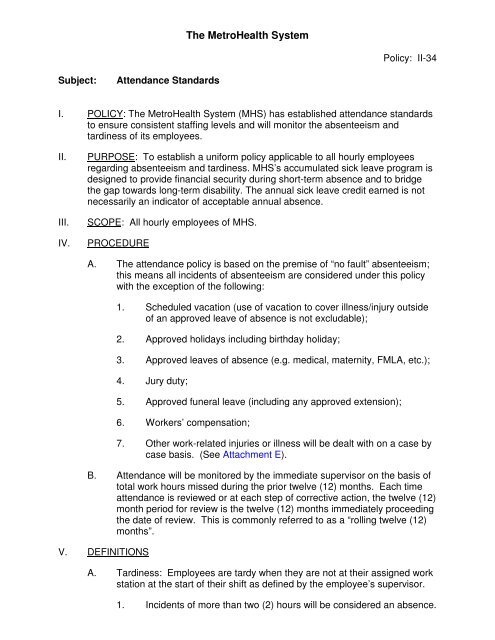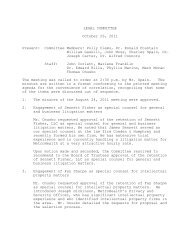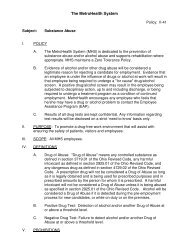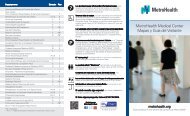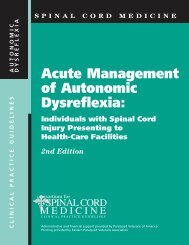Attendance Standards Policy II-34 - The MetroHealth System
Attendance Standards Policy II-34 - The MetroHealth System
Attendance Standards Policy II-34 - The MetroHealth System
You also want an ePaper? Increase the reach of your titles
YUMPU automatically turns print PDFs into web optimized ePapers that Google loves.
Subject: <strong>Attendance</strong> <strong>Standards</strong><br />
<strong>The</strong> <strong>MetroHealth</strong> <strong>System</strong><br />
<strong>Policy</strong>: <strong>II</strong>-<strong>34</strong><br />
I. POLICY: <strong>The</strong> <strong>MetroHealth</strong> <strong>System</strong> (MHS) has established attendance standards<br />
to ensure consistent staffing levels and will monitor the absenteeism and<br />
tardiness of its employees.<br />
<strong>II</strong>. PURPOSE: To establish a uniform policy applicable to all hourly employees<br />
regarding absenteeism and tardiness. MHS’s accumulated sick leave program is<br />
designed to provide financial security during short-term absence and to bridge<br />
the gap towards long-term disability. <strong>The</strong> annual sick leave credit earned is not<br />
necessarily an indicator of acceptable annual absence.<br />
<strong>II</strong>I. SCOPE: All hourly employees of MHS.<br />
IV. PROCEDURE<br />
A. <strong>The</strong> attendance policy is based on the premise of “no fault” absenteeism;<br />
this means all incidents of absenteeism are considered under this policy<br />
with the exception of the following:<br />
1. Scheduled vacation (use of vacation to cover illness/injury outside<br />
of an approved leave of absence is not excludable);<br />
2. Approved holidays including birthday holiday;<br />
3. Approved leaves of absence (e.g. medical, maternity, FMLA, etc.);<br />
4. Jury duty;<br />
5. Approved funeral leave (including any approved extension);<br />
6. Workers’ compensation;<br />
7. Other work-related injuries or illness will be dealt with on a case by<br />
case basis. (See Attachment E).<br />
B. <strong>Attendance</strong> will be monitored by the immediate supervisor on the basis of<br />
total work hours missed during the prior twelve (12) months. Each time<br />
attendance is reviewed or at each step of corrective action, the twelve (12)<br />
month period for review is the twelve (12) months immediately proceeding<br />
the date of review. This is commonly referred to as a “rolling twelve (12)<br />
months”.<br />
V. DEFINITIONS<br />
A. Tardiness: Employees are tardy when they are not at their assigned work<br />
station at the start of their shift as defined by the employee’s supervisor.<br />
1. Incidents of more than two (2) hours will be considered an absence.
<strong>Attendance</strong> <strong>Standards</strong> <strong>Policy</strong>: <strong>II</strong>-<strong>34</strong> (2)<br />
2. <strong>The</strong> six (6) minutes that are not docked on payroll are due to a<br />
payroll process. It is not a grace period for being tardy.<br />
B. Absence: Employees are absent when they fail to report on the job for a<br />
work shift regardless of whether a timely call in was made to report their<br />
absence.<br />
C. No Call/No Show: Failure to notify your immediate supervisor (or<br />
departmental designated alternate) of an absence (unless failure to give<br />
notice was reasonably beyond the control of the employee).<br />
D. Late Call: Failure to notify your immediate supervisor (or department<br />
designated alternate) at least two hours prior to the designated starting<br />
time.<br />
1. Calls received more than one (1) hour after the designated starting<br />
time notifying the supervisor that an employee will be absent (i.e.<br />
will not be reporting to work or will be reporting more than two (2)<br />
hours after the start time) will be treated in the same manner as “no<br />
call” and the employee shall receive five (5) points for each hour of<br />
absence.<br />
2. Calls received less than 2 hours prior to the designated start time<br />
will result in NO payment of sick time.<br />
E. Full Time/ Part Time: For the purpose of this policy, full-time employees<br />
are those individuals who are regularly scheduled to work sixty (60) hours<br />
bi-weekly or more. Part-time employees are those individuals who are<br />
regularly scheduled to work less than sixty (60) hours bi-weekly.<br />
F. Pandemic: A widespread disease outbreak for which people have little or<br />
no immunity.<br />
VI. ASSIGNMENT OF ATTENDANCE POINTS<br />
A. <strong>Attendance</strong> points will be assigned as listed below:<br />
1. Absence - One (1) point for every hour or portion of an hour of the<br />
shift (i.e. eight (8) hours scheduled equals eight (8) points) that an<br />
employee is absent. Incidents of more then two (2) hours tardiness<br />
will be considered an absence.<br />
2. Holiday: Absence before or after paid time off or absences on<br />
holidays on which an employee is scheduled to work. Two (2)<br />
points for every hour or portion of an hour of the shift (i.e. eight (8)<br />
hours scheduled equals sixteen (16) points).<br />
3. No Call/No Show - Five (5) points for every hour or portion of an<br />
hour of the shift (i.e. eight (8) hours scheduled equals forty (40)<br />
points).
<strong>Attendance</strong> <strong>Standards</strong> <strong>Policy</strong>: <strong>II</strong>-<strong>34</strong> (3)<br />
a) Include late calls received more than one (1) hour after<br />
designated start time.<br />
b) Such absences for three or more consecutive work days<br />
(unless failure to give notice was beyond the reasonable<br />
control of the employee) will result in termination of<br />
employment.<br />
4. Overtime: Employees scheduled to work overtime or who<br />
voluntarily accepts overtime assignment will be subject to the<br />
provisions of these standards.<br />
B. Absence combined with Tardy: After receiving a final written warning for<br />
either attendance or tardiness violations, an employee may be terminated<br />
for five (5) incidents of tardiness or the accrual of twenty-four (24) points<br />
for attendance violations (fourteen (14) points if on part-time status).<br />
C. Patterned Absences: Patterned absences, i.e. those in conjunction with<br />
planned time off and/or weekends, will be dealt with under the Corrective<br />
Action <strong>Policy</strong> <strong>II</strong>-36.<br />
D. Medical Appointments<br />
1. For up to three (3) medical appointments per calendar year,<br />
employees will not receive attendance points for a maximum of<br />
three (3) hours per medical appointment<br />
2. Employees must request approval in writing from their immediate<br />
supervisor at least seventy-two (72) hours in advance of the<br />
appointment.<br />
3. Employees are required to use their best efforts to schedule<br />
appointments so as not to disrupt <strong>System</strong> operations.<br />
4. Supervisors will notify employees whether the appointment time is<br />
approved as soon as possible.<br />
5. To be exempt from attendance points, employees must present<br />
documentation to their immediate supervisors that they attended<br />
the appointment on their next scheduled workday.<br />
6. Points will be assigned for work time off in excess of three (3) hours<br />
or for appointments beyond the three (3) in a calendar year.<br />
E. Illness: Points will be assessed for every hour or portion of an hour that<br />
an employee leaves work early because of an illness (i.e., an employee<br />
who leaves work because of illness three (3) hours before the end of the<br />
shift will be assessed three (3) points. Partial hours are to be rounded UP<br />
to the nearest full hour.
<strong>Attendance</strong> <strong>Standards</strong> <strong>Policy</strong>: <strong>II</strong>-<strong>34</strong> (4)<br />
F. Pandemic Influenza<br />
1. Guidelines for pandemic influenza pertain only to employees. Time<br />
off for family members is addressed under <strong>Policy</strong> <strong>II</strong>-20 Leaves of<br />
Absence and <strong>Policy</strong> <strong>II</strong>-42 Family and Medical Leave.<br />
2. Leave duration for pandemic flu must not exceed 5 days, including<br />
the 24 hours after the employee is free of a fever. Leaves in excess<br />
of 3 or more days, may qualify for FMLA.<br />
3. Employees who have symptoms of influenza-like illness must call-in<br />
and notify their supervisor of their symptoms and absence in<br />
accordance with the call-off procedures for their department. Those<br />
that do call-off for influenza-like illness must come into the<br />
Employee Health Clinic for further evaluation within 24 hours of<br />
calling off. If the absence occurs during a weekend/after-hours shift,<br />
the employee must contact the Employee Health Clinic on the next<br />
business day. <strong>The</strong> Employee Health Clinic is open from 7:30 am -<br />
4:00 pm Monday - Friday.<br />
4. Employees experiencing influenza-like illness during work hours<br />
must notify their supervisor immediately for referral to the Employee<br />
Health Clinic for clearance to leave. If the Employee Health Clinic is<br />
not open, employees can page the AMO on duty at #1181.<br />
5. Upon returning to work, employees must report to the Employee<br />
Health Clinic for clearance to return to work and to receive a<br />
Clearance to Work Letter to give to their supervisor/timekeeper,<br />
unless a doctor’s note can be provided.<br />
6. All pandemic influenza leaves of absence will also be monitored<br />
based on data from MHS Infectious Disease and the Cuyahoga<br />
County Board of Health prevalence reports.<br />
7. Failure to adhere to these guidelines will result in applicable<br />
consequences as outlined in this policy. Points will not be assessed<br />
provided that these guidelines have been followed.<br />
G. Payment: Employee who fails to notify their immediate supervisor (or<br />
departmental designated alternate) in violation of the call-in procedure will<br />
not be able to use any paid leave for the absence. To be eligible for paid<br />
leave, employees must call at least two hours prior to the designated<br />
starting time.<br />
H. Calculation: <strong>The</strong> standards of absenteeism are determined by the<br />
employee’s status (i.e., full-time or part-time) and are based upon a rolling<br />
twelve (12) month period or less. (See Attachment A).
<strong>Attendance</strong> <strong>Standards</strong> <strong>Policy</strong>: <strong>II</strong>-<strong>34</strong> (5)<br />
I. Tardiness: <strong>The</strong> standards for tardiness are based upon a rolling twelve<br />
(12) month period or less, regardless of the employee’s status. (See<br />
Attachment A).<br />
J. Six-Month Roll-off: When employees receive no attendance points for six<br />
(6) months (starting from the date of absence for which the last<br />
attendance points were received), points will be deleted as follows:<br />
1. Full-time employees who receive no attendance points for six (6)<br />
consecutive months will have sixteen (16) attendance points<br />
deleted from their attendance record.<br />
2. Part-time employees who receive no attendance points for six (6)<br />
consecutive months shall have ten (10) attendance points deleted<br />
from their attendance records.<br />
3. Employee’s attendance point totals shall not be reduced below<br />
zero.<br />
4. <strong>Attendance</strong> points will be deleted in the order that they were<br />
received, i.e., the points that are deleted shall correspond to the<br />
earliest dates for which attendance points were received.<br />
K. Worker’s Compensation: Initial day of injury does not accrue points. For<br />
additional information refer to Attachment E.<br />
V<strong>II</strong>. CHANGE IN STATUS<br />
A. When employees change status from Full-time to Part-time their point total<br />
will be converted to the part-time standards by multiplying their points by<br />
three-fifths (.6). Example: An employee is a full-time employee who<br />
currently has reached eighty (80) points and has already received a<br />
written warning. That employee then transfers to a part-time position (less<br />
than sixty (60) hours biweekly). <strong>The</strong> attendance points will be converted<br />
to “slotted” into the part-time standards. <strong>The</strong> employee’s new point total<br />
will be forty-eight (48). (80 points x .6 = 48 points).<br />
B. <strong>The</strong> same procedure would be used when an employee moves from parttime<br />
to full-time, except the multiplier used would be five-thirds (1.67).<br />
C. All future roll-off time should also have the points converted so that the<br />
proper deductions are applied.<br />
V<strong>II</strong>I. NEW HIRE PROBATIONARY EMPLOYEES<br />
A. Employees who are serving their initial probationary period shall receive<br />
attendance points in the same manner as all other employees. However,<br />
the attendance of these employees shall be evaluated based on a<br />
standard that takes into account their probationary status. (See
<strong>Attendance</strong> <strong>Standards</strong> <strong>Policy</strong>: <strong>II</strong>-<strong>34</strong> (6)<br />
Attachment B). This does not apply to probations connected to the “bid”<br />
process.<br />
B. If a probationary employee accumulates more than thirty-two (32) points at<br />
any one time, during the first ninety (90) days of employment, discharge<br />
will result. For example, one full day of no call/no show would result in<br />
forty (40) points and termination of employment. All recommendations for<br />
discharge must be reviewed and approved by the Division of Employee<br />
and Labor Relations.<br />
C. Consecutive days of absence due to hospitalization or communicable<br />
disease will be reviewed on a case by case basis by the employee’s<br />
department and the Division of Employee and Labor Relations.<br />
D. After successful completion of the probationary period, the employee’s<br />
point total will be assessed and the employee will be informed of the point<br />
status under the standard for regular full-time or part-time employees.<br />
IX. CROSS REFERENCE<br />
A. <strong>Policy</strong> <strong>II</strong>-19 Holidays<br />
B. <strong>Policy</strong> <strong>II</strong>-20 Leaves of Absence<br />
C. <strong>Policy</strong> <strong>II</strong>-23 Vacation<br />
D. <strong>Policy</strong> <strong>II</strong>-30 Employee Work-Related Illness/Injury Investigation<br />
E. <strong>Policy</strong> <strong>II</strong>-36 Corrective Action<br />
F. <strong>Policy</strong> <strong>II</strong>-42 Family and Medical Leave<br />
X. ATTACHMENTS<br />
A. <strong>Attendance</strong> <strong>Standards</strong> for Full-Time & Part-Time Employees<br />
B. <strong>Attendance</strong> <strong>Standards</strong> for New Hire Probationary Employees<br />
C. Record of Absenteeism<br />
D. Record of Tardiness<br />
E. Worker’s Compensation Explanation<br />
F. Record of Discussion Notice<br />
G. Corrective Action Report<br />
H. Instructions For Completing Corrective Action Report<br />
I. Probationary Warning Notice<br />
XI. DATES<br />
A. Initiated: January 1, 1996<br />
B. Reviewed/Revised:<br />
1. January 1997<br />
2. February 2000
<strong>Attendance</strong> <strong>Standards</strong> <strong>Policy</strong>: <strong>II</strong>-<strong>34</strong> (7)<br />
X<strong>II</strong>. APPROVED<br />
3. April 2003<br />
4. October 2007<br />
5. October 2009<br />
6. November 2009<br />
7. December 2009<br />
8. December 2011<br />
Mark J. Moran<br />
President and Chief Executive Officer


